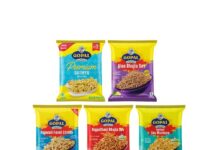The performance of metal detectors in food product inspection can sometimes be compromised by what is known as the ‘product effect’. But what is the product effect? What causes it? And how can food manufacturers tackle it? Rob Stevens, market manager, Mettler-Toledo Safeline Metal Detection, has the answers.
There is a misconception in the food manufacturing market that the ‘product effect’ – i.e. the phenomenon in which metal detectors are falsely triggered by the characteristics of the product itself – is simply caused by ‘wet’ products or those with high moisture or salt content. Whilst ‘dry’ products, such as bags of flour, will not cause a false trigger. It is true that wet products, as defined, are more likely to cause this product effect, leading to less effective metal detection, but other factors, as we shall see, can contribute too. On the factory floor, this means that products might be identified as contaminated by the metal detector and therefore unnecessarily rejected, which is a waste of good products.
The product effect happens when a metal detector’s magnetic field is disturbed while inspecting a product. The magnetic field can be disturbed not just by metal particles (i.e., an actual metal contaminant) but by other magnetic or electrically conductive aspects of the product and the environment. The interference in the detector’s magnetic field is picked up by receiver coils in the system and then evaluated by the metal detector. If the signal sent out by this magnetic interference is sufficient, the detector will consider it has found a contaminant and the product will be rejected.
Clearly, this compromises the performance of the metal detector. Its job is to detect metal contaminants, yet other factors that are not contaminants are causing a disruption to its operation, and costing the manufacturer profits due to good, uncontaminated products being thrown away.
Food manufacturers need to understand the causes of the product effect phenomenon better, as well as understand how it can be tackled. Let’s look first at the different causes of product effect, which can be divided into two separate categories:
- Characteristics of the product
Moisture or salt content (i.e., ‘wet’ products), temperature, size and shape, and consistency and density of the product can all contribute to product effect.
Moisture or salt content – although neither moisture nor salt content causes as strong a disturbance in magnetic fields as that initiated by most metals, it is generally enough for some interference to take place, thereby disrupting the performance of the metal detector. Without a doubt, this is a major cause of the product effect, and most manufacturers are aware of it. However, the matter is complicated further by the fact that moisture or salt levels are typically not consistent from one pack to the next. To use beef as an example, from one animal to the next, from one cut of the joint to the next, there can be significant variations in moisture and salt content. Marinated products can also affect metal detector performance inconsistently.
Temperature of the product – not only does temperature affect the interference a product can have on a metal detector, but the product effect itself is also under continuous change as temperature changes. For example, a deep-frozen product, generally below -18 °C, has almost zero conductivity, but as it begins to thaw and condensation forms, its conductivity changes. The signal generated by a product that is chilled is, therefore, much altered from that generated in its frozen state, and the product effect as it passes through a metal detector is significantly different.
Size and shape of the product – a consistent product signal is emitted by products that are uniform in shape and size (discounting the other factors discussed here). Many packaged products have good uniformity, but this is not always true. A conveyor belt full of whole fresh chickens, for example, will not have this uniformity. There will be variations in size, shape, and weight, and typically the larger chickens will give a stronger product signal than the smaller ones. The product effect is, therefore, inconsistent and unpredictable.
Consistency and density of the product – ready meals are a great example of this. They are usually composed of different food substances, each with different density and consistency properties. The ratios of each element can also be variable from pack to pack. This presents a big challenge in product inspection, as these variations lead to inconsistent product signals during metal detection. Even within the same ingredient, there can be variations in consistency and density. An example is bone content in meat: the amount of bone will probably not be homogenous throughout a batch of products, or even from one pack to another. Possible complications in metal detection, caused by the product effect, are the result.
2. External Factors
Position and orientation when going through the detector – inconsistent position and orientation of products on the metal detector’s conveyor belt influence product effect. For example, a different signal is given to the metal detector if a rectangular product passes through with its short edge leading, instead of its long edge. An understanding of metal detection operation also throws light on the importance of product positioning. Products passing through the center of a metal detector’s aperture are going through the weakest part of the magnetic field, and therefore any product effect relative to the magnetic field is greater. The magnetic field is strongest at the sides, so the impact of the product effect here is different again.
Packaging material – packaging made from metalized film (typically, a thin aluminum coating on plastic material) can have high conductivity, and therefore the potential for significant product effect. Also, the same specification of metalized film from different suppliers will produce varying product effect results. Inspecting the products for metal contaminants before they are packaged is of course one solution. However, products packaged in metalized film can still be effectively inspected using an advanced metal detection system using multi-simultaneous technology.
How Metal Detection Technology Overcomes Product Effect
So, what’s the solution to product effect? It is critical that food manufacturers get the best metal detection technology on board, and that they understand how best to utilize the investment they have made. Such an approach carries the bonus of making efficiency improvements possible too.

For example, a true understanding of metal detection technology, metal contamination, and of your application, allows you to optimize the frequency of metal detection performance to make product effect interference less likely, while still giving you the best chance of detecting real contaminants. Detectors can typically operate from 25 kHz up to 1 MHz. At the higher frequency end, the detector will be better able to detect small metal contaminants, but the increased sensitivity also makes it more susceptible to disturbance by product effect. Using lower frequencies entails the opposite compromise: less risk of product effect being an issue, but reduced ability to detect small metal contaminants. Food manufacturers should make it their business to learn how to set up product inspections to get the right balance for their products. This will result in safer food, and less wasted products through false rejects.
Equipment suppliers have been battling the problems that product effect causes to food manufacturers, resulting in technological advances that help mitigate the phenomenon. One such advance has been the launch of MSF (Multi-Simultaneous-Frequency) metal detectors. By using combinations of two or more frequencies at a time, MSF makes the compromise between product effect, operating frequency, and metal detector sensitivity less dramatic.
In addition, advanced discrimination techniques have been developed that use multiple frequencies to minimize product signals. Higher detection capability can therefore be gained during product inspection, even for product types that typically have a high product effect.
Another breakthrough technology is the dedicated Digital Signal Processor that some of today’s metal detection systems include, which is designed to handle “phase discrimination” and other advanced signal processing techniques. Phase discrimination works by learning the characteristics of a product effect signal and those of a real metal contaminant signal and discriminating between these signals to amplify that of the contaminant while reducing or ignoring the product signal. The combination of the Digital Signal Processor with MSF makes it much easier for metal detection systems to identify small metal contaminants, even when the product effect is high.
Clearly, food manufacturers can gain a head-start in tackling product effect by investing in the right metal detection systems. Technology advances have made it possible to limit the damage that product effect does to effective product inspection. Better contaminant detection, improved efficiency and greater confidence in the quality and safety of manufactured food products, however high their product effect, should be the result.
To download a whitepaper on this subject, click here.
(Rob Stevens is the market manager for Mettler-Toledo Safeline Metal Detection, supporting several territories with the sales and service of metal detectors. Rob has a degree in Manufacturing Engineering and has worked in the food industry internationally, providing solutions to some of the world’s biggest food producers.)
IndiFoodBev — authentic, impactful and influential
An English-language food and beverage processing and packaging industry B2B platform in print and web, IndiFoodBev is in its third year of publication. It is said that the Indian food and beverage industries represent approximately US$ 900 billion in revenues which implies more than 20% of the country’s GDP. Eliminating the wastage on the farmside can help to deliver more protein to a higher number of the population apart from generating sizable exports. The savings in soil, seeds, water, fertilizer, energy and ultimately food and nutrition could be the most immense contribution that country is poised to make to the moderation of climate change.
To improve your marketing and grow sales to the food and beverage processing and packaging industry, talk to us. Our research and consulting company IppStar [www.ippstar.org] can assess your potential and addressable markets in light of the competition. We can discuss marketing, communication, and sales strategies for market entry and growth.
Suppliers and service providers with a strategy and budget for targeted marketing can discuss using our hybrid print, web, video, and social media channels to create brand recognition linked to market relevance. Our technical writers are ready to meet you and your customers for content.
The second largest producer of fruit and vegetables in the world is continuously expanding processing capacities and delivery systems with appropriate innovative technologies. We cover product and consumer trends, nutrition, processing, research, equipment and packaging from farm to thali. Get our 2025 media kit and recalibrate your role in this dynamic market. Enhance your visibility and relevance to existing markets and turn potential customers into conversations. Ask for a sample copy of our bi-monthly in print or our weekly IndiFoodBev eZine each Wednesday.
For editorial info@ippgroup.in — for advertisement ads1@ippgroup.in and for subscriptions subscription@ippgroup.in
Naresh Khanna – 10 February 2025
Subscribe Now








